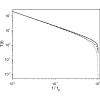当前位置:
X-MOL 学术
›
Phys. Rev. E
›
论文详情
Our official English website, www.x-mol.net, welcomes your
feedback! (Note: you will need to create a separate account there.)
Nonequilibrium kinetics of excess defect generation and dynamic scaling in the Ising spin chain under slow cooling.
Physical Review E ( IF 2.2 ) Pub Date : 2020-07-06 , DOI: 10.1103/physreve.102.012114 Kangeun Jeong 1 , Bongsoo Kim 1, 2 , Sung Jong Lee 2, 3
Physical Review E ( IF 2.2 ) Pub Date : 2020-07-06 , DOI: 10.1103/physreve.102.012114 Kangeun Jeong 1 , Bongsoo Kim 1, 2 , Sung Jong Lee 2, 3
Affiliation

|
We investigate the relaxation dynamics of a one-dimensional Ising chain via Glauber kinetic Monte Carlo simulations, when the system is cooled slowly from infinite temperature to zero temperature with different cooling protocols. The main quantity of interest is the excess defect density that represents the total defect density minus the equilibrium defect density at varying temperatures. We find that, for three classes of cooling protocols, the time dependence of the excess defect density for various cooling speed shows a dynamic scaling behavior that largely encompasses the Kibble-Zurek mechanism as well as Krapivsky's calculation of the final defect density at zero temperature. We also find distinct features in the behavior of the dynamic scaling when the temperature approaches in a power-law fashion to zero temperature and the excess defect density reaches a peak at finite temperature, where the scaling of the excess defect density at its peak and that at zero temperature exhibits different asymptotic behavior due to different logarithmic corrections. This characteristic behavior can be attributed to the exponential divergence of the relaxation time near zero temperature. While the qualitative theoretical predictions by Krapivsky on the asymptotic exponents are confirmed, the asymptotic predictions for amplitudes overestimate by up to the simulation results.
中文翻译:

在缓慢冷却下,Ising自旋链中过量缺陷生成和动态缩放的非平衡动力学。
我们通过Glauber动力学蒙特卡洛模拟研究一维Ising链的弛豫动力学,当系统使用不同的冷却协议从无限温度缓慢冷却到零温度时,它会进行冷却。关注的主要数量是多余的缺陷密度,它表示总的缺陷密度减去在不同温度下的平衡缺陷密度。我们发现,对于三类冷却协议,各种冷却速度下过量缺陷密度的时间依赖性显示出动态缩放行为,该行为主要包含Kibble-Zurek机制以及Krapivsky对零温度下最终缺陷密度的计算。当温度以幂律方式接近零温度并且过量缺陷密度在有限温度下达到峰值时,我们还会发现动态缩放行为的显着特征,其中过量缺陷密度在其峰值处以及由于对数校正不同,在零温度下的温度表现出不同的渐近行为。这种特征行为可以归因于接近零温度的弛豫时间的指数发散。在确认了Krapivsky对渐近指数的定性理论预测后,幅度的渐近预测高估了 其中,由于对数校正不同,多余缺陷密度在其峰值处和零温度处的缩放比例表现出不同的渐近行为。这种特征行为可以归因于接近零温度的弛豫时间的指数发散。在确认了Krapivsky对渐近指数的定性理论预测后,幅度的渐近预测高估了 其中,由于对数校正不同,多余缺陷密度在其峰值处和零温度处的缩放比例表现出不同的渐近行为。这种特征行为可以归因于接近零温度的弛豫时间的指数发散。在确认了Krapivsky对渐近指数的定性理论预测后,幅度的渐近预测高估了 仿真结果。
更新日期:2020-07-06
中文翻译:

在缓慢冷却下,Ising自旋链中过量缺陷生成和动态缩放的非平衡动力学。
我们通过Glauber动力学蒙特卡洛模拟研究一维Ising链的弛豫动力学,当系统使用不同的冷却协议从无限温度缓慢冷却到零温度时,它会进行冷却。关注的主要数量是多余的缺陷密度,它表示总的缺陷密度减去在不同温度下的平衡缺陷密度。我们发现,对于三类冷却协议,各种冷却速度下过量缺陷密度的时间依赖性显示出动态缩放行为,该行为主要包含Kibble-Zurek机制以及Krapivsky对零温度下最终缺陷密度的计算。当温度以幂律方式接近零温度并且过量缺陷密度在有限温度下达到峰值时,我们还会发现动态缩放行为的显着特征,其中过量缺陷密度在其峰值处以及由于对数校正不同,在零温度下的温度表现出不同的渐近行为。这种特征行为可以归因于接近零温度的弛豫时间的指数发散。在确认了Krapivsky对渐近指数的定性理论预测后,幅度的渐近预测高估了 其中,由于对数校正不同,多余缺陷密度在其峰值处和零温度处的缩放比例表现出不同的渐近行为。这种特征行为可以归因于接近零温度的弛豫时间的指数发散。在确认了Krapivsky对渐近指数的定性理论预测后,幅度的渐近预测高估了 其中,由于对数校正不同,多余缺陷密度在其峰值处和零温度处的缩放比例表现出不同的渐近行为。这种特征行为可以归因于接近零温度的弛豫时间的指数发散。在确认了Krapivsky对渐近指数的定性理论预测后,幅度的渐近预测高估了 仿真结果。









































 京公网安备 11010802027423号
京公网安备 11010802027423号